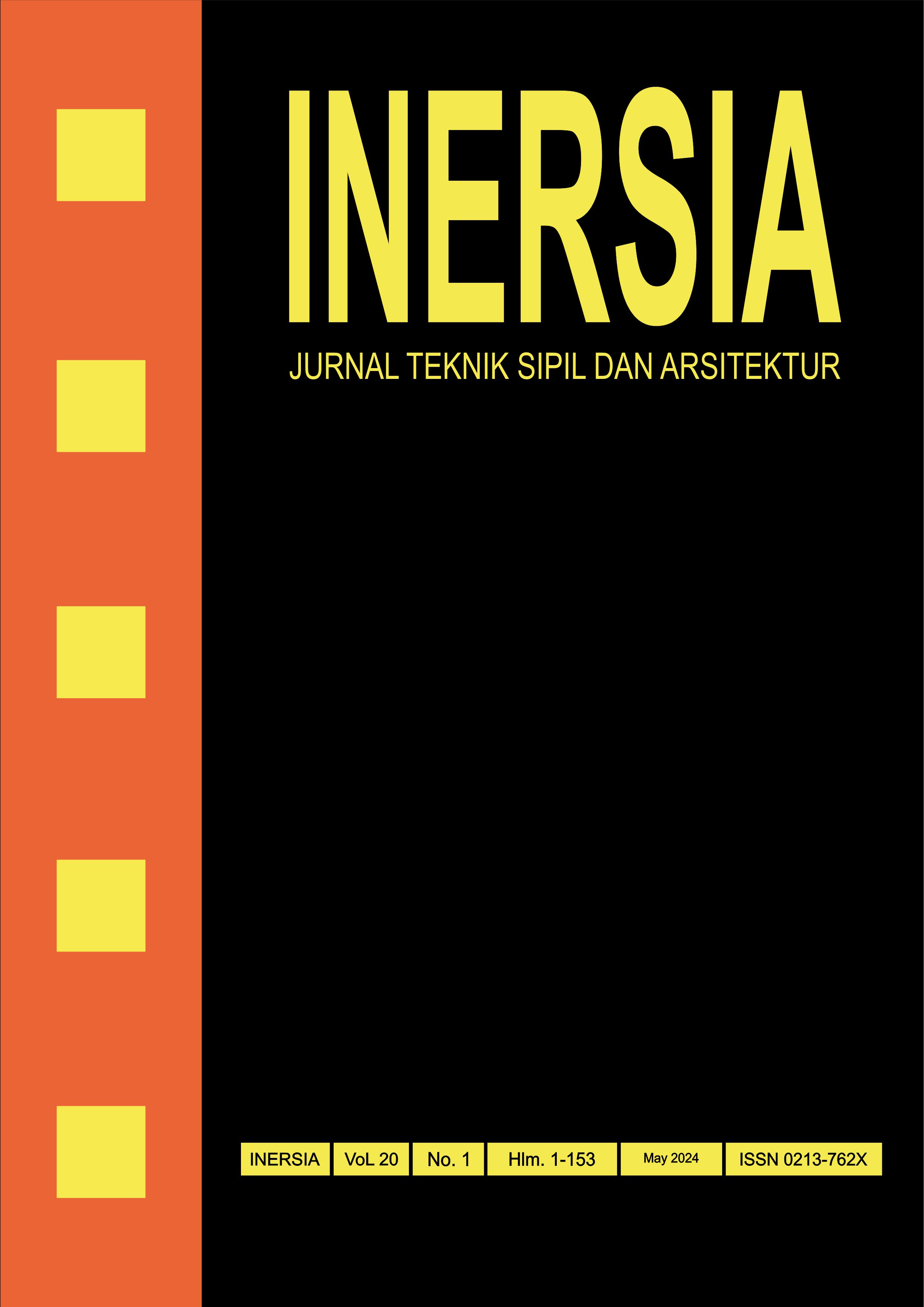Bridge Assessment Analysis using Sufficiency Rating Method (Case Study of The Mungkung Overpass)
DOI:
https://doi.org/10.21831/inersia.v20i1.71348Keywords:
Bridge Assessment, Mungkung Overpass, Sufficiency RatingAbstract
Bridges play a crucial role in connecting various routes and water bodies, necessitating regular monitoring to prevent potential hazards and losses due to deterioration. In Indonesia employs the Bridge Management System (BMS) for decision-making regarding maintenance, repair, and replacement activities, its reliance on a limited set of criteria may lead to uncertainties in bridge condition assessmsents. This study explores the Sufficiency Rating (SR) method as an alternative for assessing bridge feasibility. By considering multiple factors, including structural adequacy, serviceability, functionality, and public interest, the SR method offers a comprehensive approach to bridge evaluation. An analysis of the Mungkung Overpass on the Ngawi Kertasono toll road was conducted to evaluate the effectiveness of the SR method. The findings classified the bridge as excellent, indicating no immediate need for treatment. However, the SR method has limitations, particularly in visually assessing damage to superstructure and substructure elements, which may introduce subjectivity. Overall, this research contributes to the ongoing development of bridge assessment methodologies in Indonesia, aiming to enhance decision-making processes and ensure the safety and longevity of bridge infrastructure. After analyzing the data obtained through the implementation of the SR method, it was revealed that S1 achieved a value of 45%, S2 achieved 23%, S3 achieved 12.7%, and S4 achieved 6%. The total actual value of the four parameters calculated based on the SR method was 74.7%, with a difference of 25.3% from the maximum value. These findings clearly illustrated that the bridge satisfied the criteria for deficiency, thereby necessitating comprehensive rehabilitation measures to be undertaken.
References
M. Aflatooni, T. H. T. Chan, and D. P. Thambiratnam, "Condition monitoring and rating of bridge components in a rail or road network by using SHM systems within SRP," Structural Monitoring and Maintenance, vol. 2, no. 3, pp. 199–211, Sep. 2015, doi: 10.12989/smm.2015.2.3.199.
Direktorat Jendral Bina Marga (Kementrian Pekerjaan Umum dan Perumahan Rakyat), "Pemeriksaan Jembatan," Jakarta, 2022.
U.S. Department of Transportation (Federal Highway Administration), "The Recording and Coding Guide for the Structure Inventory and Appraisal of the Nation's Bridge," Washington, 1995.
E. Puls, M. B. D. Hueste, S. Hurlebaus, and I. Damnjanovic, "Prioritization of a Bridge Inventory for Historic Preservation: A Case Study for Tarrant County, Texas," Public Works Management and Policy, vol. 23, no. 3, pp. 205–220, Jul. 2018, doi: 10.1177/1087724X18757533.
M. Stevens and R. Tuchscherer, "Quantifying a Bridge's Structural Resilience," Practice Periodical on Structural Design and Construction, vol. 25, no. 4, Nov. 2020, doi: 10.1061/(asce)sc.1943-5576.0000517.
C. Pellegrino, A. Pipinato, and C. Modena, "A simplified management procedure for bridge network maintenance," Structure and Infrastructure Engineering, vol. 7, no. 5, pp. 341–351, May 2011, doi: 10.1080/15732470802659084.
J. Weissmann, A. J. Weissmann, and A. Montoya, "Deterioration Models for Texas Bridges and Culverts," Transp Res Rec, vol. 2677, no. 7, pp. 307–316, Jul. 2023, doi: 10.1177/03611981231152460.
D. Y. Yang and D. M. Frangopol, "Risk-Informed Bridge Ranking at Project and Network Levels," Journal of Infrastructure Systems, vol. 24, no. 3, Sep. 2018, doi: 10.1061/(asce)is.1943-555x.0000430.
A. L. Ramdhani and Sumargo, "Comparison of Condition Rating and Bridge Remaining Life Based on Bridge Management System and Bridge Condition Ratio," Advances in Engineering Research, vol. 198, 2020, doi: 10.2991/aer.k.201221.033.
A. Y. Pratiwi, N. Chairunnisa, I. Prasetia, I. F. Radam, and R. Nurwidayati, "Bridge Management System dan Bridge Condition Rating pada Evaluasi Kondisi Jembatan Girder Baja Komposit di Kabupaten Tapin," Buletin Profesi Insinyur, vol. 6, no. 1, pp. 26–31, Jan. 2023, doi: 10.20527/bpi.v6i1.180.
S. Inkoom, J. O. Sobanjo, P. D. Thompson, R. Kerr, and R. Twumasi-Boakye, "Bridge health index: Study of element condition states and importance weights," Transp Res Rec, vol. 2612, pp. 67–75, 2017, doi: 10.3141/2612-08.
S. Inkoom and J. Sobanjo, "Availability function as bridge element's importance weight in computing overall bridge health index," Structure and Infrastructure Engineering, vol. 14, no. 12, pp. 1598–1610, Dec. 2018, doi: 10.1080/15732479.2018.1476561.
A. M. Abdelmaksoud, T. C. Becker, and G. P. Balomenos, "Statistical analysis of bridge management system inspection data," in 20th Congress of IABSE, New York City 2019: The Evolving Metropolis - Report, International Association for Bridge and Structural Engineering (IABSE), 2019, pp. 898–902. doi: 10.2749/newyork.2019.0897.
M. Taghaddos and Y. Mohamed, "Predicting Bridge Conditions in Ontario: A Case Study," International Symposium on Automation and Robotics in Construction Journal, 2019, doi: 10.22260/ISARC2019/0023.
P. Martinez, E. Mohamed, O. Mohsen, and Y. Mohamed, "Comparative Study of Data Mining Models for Prediction of Bridge Future Conditions," Journal of Performance of Constructed Facilities, vol. 34, no. 1, Feb. 2020, doi: 10.1061/(asce)cf.1943-5509.0001395.
S. Darban, H. G. Tehrani, N. Karballaeezadeh, and A. Mosavi, "Application of analytical hierarchy process for structural health monitoring and prioritizing concrete bridges in iran," Applied Sciences (Switzerland), vol. 11, no. 17, Sep. 2021, doi: 10.3390/app11178060.
U.S. Department of Transportation (Federal Highway Administration), "Specifications for the National Bridge Inventory," Washington, 2022.
U.S. Department of Transportation (Federal Highway Administration), "Synthesis of National and International Methodologies Used for Bridge Health Indices," Washington, 2016. doi: 10.13140/RG.2.1.1558.1683.
U.S. Department of Transportation (Federal Highway Administration), "The Impact of Load Rating Methods on Federal Bridge Program Funding FHWA," Washington, 2005.
C. Gui, J. Zhang, J. Lei, Y. Hou, Y. Zhang, and Z. Qian, "A comprehensive evaluation algorithm for project-level bridge maintenance decision-making," J Clean Prod, vol. 289, Mar. 2021, doi: 10.1016/j.jclepro.2020.125713.
Downloads
Published
How to Cite
Issue
Section
License
Authors who publish with INERSIA journal agree to the following terms:
- Authors retain copyright and grant the INERSIA journal right of first publication with the work simultaneously licensed under Creative Commons Attribution License (CC BY 4.0) that allows others to share the work with an acknowledgment of the work's authorship and initial publication in this journal.
- Authors can enter into separate, additional contractual arrangements for the non-exclusive distribution of the published version of the work (e.g., post it to an institutional repository or edit it in a book), with an acknowledgment of its initial publication in this journal.
- Authors are permitted and encouraged to post their work online (e.g., in institutional repositories or on their website) before and during the submission process, as it can lead to productive exchanges, as well as earlier and greater citation of published work.

INERSIA by https://journal.uny.ac.id/index.php/inersia was distributed under a Creative Commons Attribution 4.0 International License











